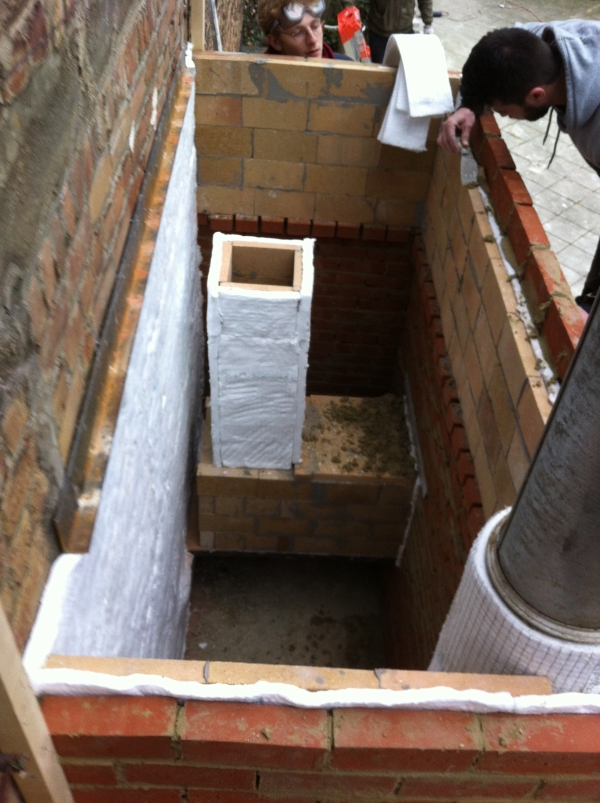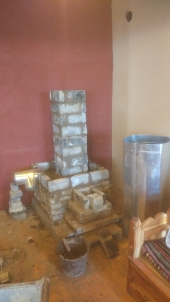





 14
14




 6
6




 5
5




Fox James wrote:Wow, it looks like you have found some nice materials to work with!
 5
5




Matteo Rossi wrote:Now i have to build the bell, i am not sure how to make it, i was hoping to use regular Red bricks with refractory panels above the riser, will they hold?
regards, Peter
 6
6




Scott Weinberg wrote:
Fox James wrote:Wow, it looks like you have found some nice materials to work with!
yes, what is that material, exactly? Most of the time, I find that the "all cost" which includes shipping and handling of anything, far exceeds our hard fire brick cost. (but then again our fire brick cost is very low in comparing to anything)
But please do tell.

 3
3




For all your Montana Masonry Heater parts (also known as) Rocket Mass heater parts.
Visit me at
dragontechrmh.com Once you go brick you will never go back!
 4
4




nice build the Mallorca, i see that you used normal bricks for everything and lined the top of the bell with ceramic blanket.Peter van den Berg wrote:
Matteo Rossi wrote:Now i have to build the bell, i am not sure how to make it, i was hoping to use regular Red bricks with refractory panels above the riser, will they hold?
Yes, the regular red bricks will hold. Refractory panels on all surfaces above the riser, walls included. Start the refractory wall panels some 10 cm below the higest point of the riser. Best to use a construction similar to the Mallorca build. https://batchrocket.eu/en/designs#squarecore
As far as I know, that one being the oldest with this bell construction, it's still in one piece. This example build is followed many times, including one in Bulgaria that experienced some harsh winters and none of those failed.
Interesting way to implement the p-channel although you are not the first one.
Test running the core outside is quite revealing, for sure.
 5
5




 3
3




Matteo Rossi wrote: nice build the Mallorca, i see that you used normal bricks for everything and lined the top of the bell with ceramic blanket.
regards, Peter
 2
2




Fox James wrote:Wow, it looks like you have found some nice materials to work with!
 4
4




 3
3




sooner or later I want to try the casting method, very interesting for this one I choosed this type of bricks because they are proven, and i want to be sure to build something reliable the first time.stephen wilson wrote:
Fox James wrote:Wow, it looks like you have found some nice materials to work with!
I second that!
I just finished casting and assembling my own batch rocket that looks a bit "heath-robinson-ey" in comparison - not because of Peter van der berg's design but because of my poor moulding skills.
Here's my first assemble of the two parts of the batch rocket, with the short length risers in position - which I still need to dry out a bit longer. (See photo).
I wonder if those refractory "lego bricks" of yours could be easily cast? Anyone here ever tried?
My batch rocket will soon be "feeling the burn"! I look forward to seeing yours in operation.
Regards
Stephen
P.S Looks like videos can't be submitted - or is it just .mp4 ?
 3
3




i have to make a double skin construction It seems. I was hoping not to. It's necessary to use the ceramic blanket? Here the builders of mass heaters leave about a cm of air between the 2 skins.Peter van den Berg wrote:
Matteo Rossi wrote: nice build the Mallorca, i see that you used normal bricks for everything and lined the top of the bell with ceramic blanket.
The top of the bell will be expanding and contracting quite a bit. So, there's an external shell that forms the construction. This lined with ceramic blanket and inside that a liner of firebricks. The inside liner can freely grow and shrink this way without cracking the external shell.
Another way to do this is to build two walls, completely separated from each other. This is called a double skin bell, with a liner of ceramic blanket between those skins so the whole of the inner skin has an expansion joint around it as well as a slip joint. The reason for this is that the inner skin will expand in all directions, vertically being the most.
It's up to you what you want. The more mass in the heater the longer it will take to warm up completely. On the other hand, a real heavy heater won't cool off for days when left alone. The Mallorca build is a half-way house, the lower part is single skin and the top part is double skin.
 5
5




Matteo Rossi wrote:i have to make a double skin construction It seems. I was hoping not to. It's necessary to use the ceramic blanket? Here the builders of mass heaters leave about a cm of air between the 2 skins.
regards, Peter
 2
2




Fox James wrote:Stephen, you could start your own thread so we can discuss your molding?
 2
2




very good i will do like you suggest. Yesterday i sourced the regular bricks for the outer skin, for the inner i plan to use 3 cm thick refractory ones that i forgot to have stashed in a corner, i think that they will do their job.Peter van den Berg wrote:
Matteo Rossi wrote:i have to make a double skin construction It seems. I was hoping not to. It's necessary to use the ceramic blanket? Here the builders of mass heaters leave about a cm of air between the 2 skins.
It's not absolutely necessary to use ceramic blanket, just very handy to ensure not a single patch is making contact between inner and outer skin. Leaving one cm of air between skins sounds doable but in practise it isn't. Somewhere in the process of building the outer skin some mortar will be spilled in the gap. Making sure there's contact and inevitably at some point in time cracks will appear in the outer skin.
Some people use cardboard between skins in order to ensure separation between skins. The cardboard will turn to coal during the first really hot burn. But one have to make very sure there aren't any leaks in the outer skin, otherwise the room will be filled with smoke. I did such a thing once, not to be repeated. I used ceramic blanket about a dozen times with commendable results and I intend to stick with that.
 4
4




Matteo Rossi wrote:Yesterday i sourced the regular bricks for the outer skin, for the inner i plan to use 3 cm thick refractory ones that i forgot to have stashed in a corner, i think that they will do their job.

regards, Peter
 4
4




good, regarding the mortar, for the regular brick i plan to use a mix of sand and lime, for the refractory part, including the firebox, i bought a specific black mortar that is ready to use, no need to add water.Peter van den Berg wrote:
Matteo Rossi wrote:Yesterday i sourced the regular bricks for the outer skin, for the inner i plan to use 3 cm thick refractory ones that i forgot to have stashed in a corner, i think that they will do their job.
Yes, that 3 cm split firebricks will do the job. Is being used before, in the Brussels build. Have a look, one of the pictures clearly shows the split bricks as the inner liner.

 5
5




Matteo Rossi wrote: good, regarding the mortar, for the regular brick i plan to use a mix of sand and lime, for the refractory part, including the firebox, i bought a specific black mortar that is ready to use, no need to add water.
regards, Peter
 7
7




Peter van den Berg wrote:
Matteo Rossi wrote:i have to make a double skin construction It seems. I was hoping not to. It's necessary to use the ceramic blanket? Here the builders of mass heaters leave about a cm of air between the 2 skins.
It's not absolutely necessary to use ceramic blanket, just very handy to ensure not a single patch is making contact between inner and outer skin. Leaving one cm of air between skins sounds doable but in practise it isn't. Somewhere in the process of building the outer skin some mortar will be spilled in the gap. Making sure there's contact and inevitably at some point in time cracks will appear in the outer skin.
Some people use cardboard between skins in order to ensure separation between skins. The cardboard will turn to coal during the first really hot burn. But one have to make very sure there aren't any leaks in the outer skin, otherwise the room will be filled with smoke. I did such a thing once, not to be repeated. I used ceramic blanket about a dozen times with commendable results and I intend to stick with that.
 6
6




Scott Weinberg wrote:We are often told to use a ceramic blanket to insulate such as a barrier on T Bars, or to wrap our riser, but then often told to use the ceramic blanket for a spacer such as above, but won't it still be a insulating material? it would seem we want all our bell to get maximum heat? or perhaps our bottom gets a bit warmer than it would without any blanket involved. just wondering about the theory, not saying anything is right or wrong.
regards, Peter
 5
5




Peter van den Berg wrote:[ .
 6
6




 5
5




 5
5




Cedric
 6
6




 12
12




 6
6




 6
6








 6
6




For all your Montana Masonry Heater parts (also known as) Rocket Mass heater parts.
Visit me at
dragontechrmh.com Once you go brick you will never go back!
 3
3





|
Do you want ants? Because that's how you get ants. And a tiny ads:
Homestead Pigs Course
https://permies.com/wiki/365748/Homestead-Pigs
|






